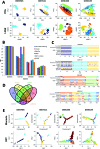Single-Cell RNA Sequencing-Based Computational Analysis to Describe Disease Heterogeneity
- PMID: 31354786
- PMCID: PMC6640157
- DOI: 10.3389/fgene.2019.00629
Single-Cell RNA Sequencing-Based Computational Analysis to Describe Disease Heterogeneity
Abstract
The trillions of cells in the human body can be viewed as elementary but essential biological units that achieve different body states, but the low resolution of previous cell isolation and measurement approaches limits our understanding of the cell-specific molecular profiles. The recent establishment and rapid growth of single-cell sequencing technology has facilitated the identification of molecular profiles of heterogeneous cells, especially on the transcription level of single cells [single-cell RNA sequencing (scRNA-seq)]. As a novel method, the robustness of scRNA-seq under changing conditions will determine its practical potential in major research programs and clinical applications. In this review, we first briefly presented the scRNA-seq-related methods from the point of view of experiments and computation. Then, we compared several state-of-the-art scRNA-seq analysis frameworks mainly by analyzing their performance robustness on independent scRNA-seq datasets for the same complex disease. Finally, we elaborated on our hypothesis on consensus scRNA-seq analysis and summarized the potential indicative and predictive roles of individual cells in understanding disease heterogeneity by single-cell technologies.
Keywords: cellular heterogeneity; complex diseases; integration; network; single-cell RNA sequencing.
Figures
References
LinkOut - more resources
Full Text Sources
Research Materials



